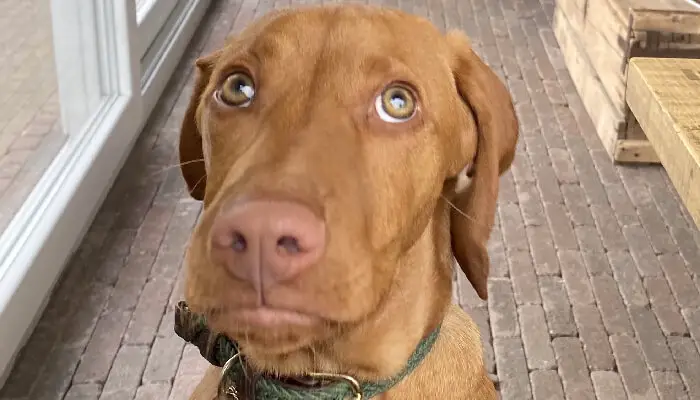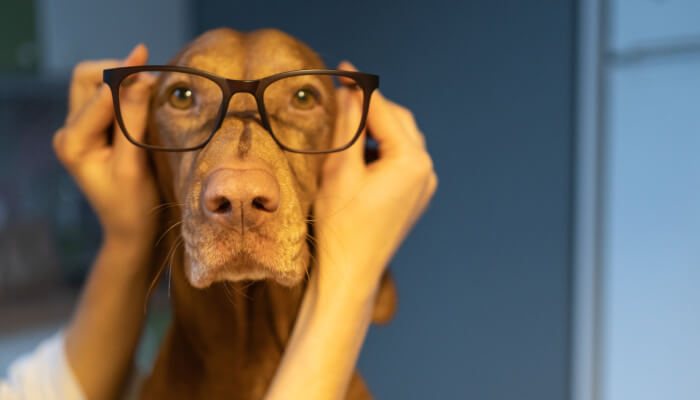Many people are confused about the color of Vizsla’s eyes. Though they may be brown, black, or yellow, their eye color can also change over time. So the most common question is: Can a Vizsla have blue eyes?
And the simple answer to that is yes! They can have any eye color as long as they have one brown and one blue iris. It is the case for all dogs. It’s completely normal to have blue eyes as a color option on your dog! As we mentioned before, even if they are brown or black in most cases, they will also have one brown and one blue iris. It is simply due to genetics.
As we know, most dogs will have one brown and one blue iris in their eyes regardless of the color that is most common for them. When a dog has two blue or partial blue eyes, it can be due to several factors: being albino, having certain health conditions, or simply genetics. However, it is important to know that blue eyes can be a sign of an underlying disorder, and you need to consult your veterinarian if it persists for more than one day.
This article will explore why this happens and what it means for your pet’s health.
Can A Vizsla Have Blue Eyes?
Yes, a Vizsla can have blue eyes.
All puppies are born with puppy-colored fur, which includes amber, brown, or black eyes, depending on their coat color. If you notice your pup’s eye color had changed from when he was an infant, call your veterinarian.
It can be due to various genotypes, the C series, pigmentation problems, or a split gene.
Did you know that there are three different Vizsla eye colors? The most common are brown, but they can be black or yellow as well!
The color of your Vizsla’s eyes depends on factors like their health and whether it’s an effect of a rare genetic mutation or not.
Is It Normal For Vizsla To Have Blue Eyes?
It is usual for a vizsla to have blue eyes, but this is not always the case. If your dog has one brown and one blue iris, then it’s best to take them in for an examination from their vet at least once every year.
Why Does My Vizsla Dog Have Blue Eyes?
There are a few different reasons your Vizsla might have blue eyes.
The most common is due to a split gene, which leads them to have two brown irises. This genetic mutation is the one that makes many people believe they have something wrong with their eyesight.
The blue-colored eyes in vizsla dogs are the result of a genetic mutation in their coat color. It is called “merle” or possibly “C series” and affects many other breeds, including Australian Shepherds, Border Collies, Chihuahuas, Dachshunds, Golden Retrievers, and Siberian Huskies, to name a few.
Some Vizslas will have more blue in their eyes than others, which can be a sign of other pigmentation problems.
Gen Merle Series
The color of your Vizsla’s eyes depends on factors like their health and whether it’s an effect of a rare genetic mutation or not.
C Series
It can cause the eye color to change between brown and blue.
Split Gene Series
If your Vizsla has this genetic mutation, the dog will have two different colors of eyes called heterochromatic or split-eye. It can also cause pigment loss in other places on their body, like patches around their lips, nose, gums, and eyelids. It is the same genetic mutation that causes deafness in many breeds of dogs. Therefore it’s important to have their hearing regularly tested as well.
Pigmentation Problems
Pigment problems can occur in Vizslas and be the cause for their blue eyes. These issues can affect your dog’s pigmentation, like being born with a lack of pigment (hypopigmented), which is most commonly seen on any white parts on their coat or around their nose and eyelids. Pigment problems can also affect just one of their pigments, which is called hyperpigmentation. It most commonly occurs in older dogs and might cause a dark-colored spot to appear on different parts of the body, like the gums around their teeth or even near their eyes.
The Vizsla is not blind. However, they have a different color of the iris than your average dog does!
Why Does The Color Of Vizsla Dog’s Eyes Change?
When you have a Vizsla with light brown eyes, they may gradually get lighter as the fats in their iris accumulate.
When you have a Vizsla with dark brown eyes, they can become darker over time.
The color of your dog’s eyes changes as they age due to the accumulation of fats in their iris. So the more light a Vizsla is exposed to over time will also make them lighter or darker, depending on how much light they get.
It is not possible to predict how a Vizsla’s eye color will change over time. The age of Vizslas and the color of their eyes all change as they get older. Some Vizslas will have more blue in their eyes than others, which can signify other pigmentation problems.
How Does The Color Of My Vizsla Dog’s Eyes Change?
The color of your dog’s eyes changes as they age due to the accumulation of fats in the iris.
The color also changes according to the quantity of light your dog is exposed to overtime. As a result, Vizsla’s eyes may be lighter or darker depending on their surroundings.
Can All Vizsla Puppies Have Blue Eyes?
Vizsla can have blue eyes if they are born with two different irises.
It is scarce, but it can happen and will cause them to be more susceptible to problems like pigmentation or split genes.
Vizslas may also get their eye color from their parents – as an example if a Vizsla has brown eyes and the other parent is blue-eyed, their puppies might have more of a chance to be born with blue eyes.
What Causes Irregular Pigmentation in Dog Eyes?
Pigmentation problems can occur when there are disruptions in the genes that regulate pigment production or regulation. These mutations may cause the color of your dog’s eyes to change, with the most common being brown.
Why Don’t Vizsla Dogs Have Blue Eyes?
It’s not uncommon for a Vizsla to have odd-colored eyes like blue or hazel – in fact, about one-third of all their litters will be born with this type of eye color.
But, the Vizsla is an all-white dog with a recessive gene that can cause variability in their coat colors and eye colors.
It means they have two different genes for each trait, and one of them must be white to get the desired effect.
Conclusion
In a nutshell, a Vizsla can have blue eyes. Many factors can cause this, including the genotype, the C series, pigmentation problems, or split gene. It’s also important to know what your dog’s eye color changes mean so you can get them checked out by their vet as soon as you notice a change in their eye color.



